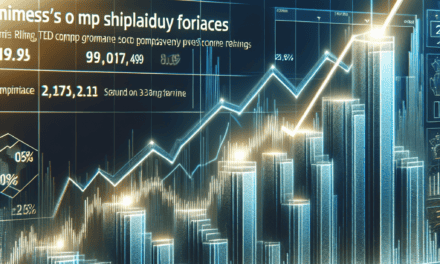“Navigate the Future: PMI Insights Shape Post-Election FX and Bond Markets”
Introduction
In the upcoming week, the foreign exchange and bond markets are poised for significant movements as investors turn their attention to the latest Purchasing Managers’ Index (PMI) data from the United States and Europe. These insights are particularly crucial as they come on the heels of recent elections, which have introduced new variables into the economic landscape. Market participants will be closely analyzing the PMI figures to gauge the health of the manufacturing and services sectors, seeking clues on how these economies are navigating post-election dynamics. The data will not only influence currency valuations but also impact bond yields, as traders adjust their expectations for future monetary policy actions. As such, the PMI releases are set to be a pivotal factor in shaping market sentiment and investment strategies in the days ahead.
Analyzing U.S. PMI Data: Implications for the FX Market
As the upcoming week unfolds, market participants are keenly focused on the release of Purchasing Managers’ Index (PMI) data from the United States, which is anticipated to provide critical insights into the economic landscape following recent electoral developments. The PMI, a vital economic indicator, offers a snapshot of the manufacturing and services sectors’ health, thereby serving as a barometer for economic activity. In the context of the foreign exchange (FX) market, the PMI data is particularly significant as it can influence currency valuations by shaping expectations about future economic performance and monetary policy directions.
In the aftermath of the U.S. elections, investors are eager to discern how political shifts might translate into economic policy changes, which in turn could impact business confidence and investment decisions. The PMI data, therefore, becomes a crucial piece of the puzzle, offering a timely gauge of whether businesses are optimistic or cautious about the future. A stronger-than-expected PMI reading could signal robust economic activity, potentially leading to an appreciation of the U.S. dollar as investors anticipate a more aggressive stance from the Federal Reserve in terms of interest rate adjustments. Conversely, a weaker PMI could suggest economic headwinds, prompting a depreciation of the dollar as market participants adjust their expectations for monetary easing.
Moreover, the PMI data’s implications extend beyond the immediate FX market reactions. It also provides insights into the broader economic trajectory, influencing bond markets as well. A positive PMI reading might lead to a sell-off in U.S. Treasuries, as investors anticipate higher interest rates and seek higher yields elsewhere. This, in turn, could result in rising bond yields, reflecting increased confidence in economic growth. On the other hand, a disappointing PMI could bolster demand for safe-haven assets like Treasuries, driving yields lower as investors seek refuge amid economic uncertainty.
Transitioning to the European context, the PMI data from major economies such as Germany and France will also be under scrutiny. The interplay between U.S. and European PMI readings can offer a comparative perspective on the relative economic strengths of these regions, further influencing FX dynamics. For instance, if European PMI data outperforms U.S. figures, it could lead to a strengthening of the euro against the dollar, as investors recalibrate their expectations for economic growth and monetary policy in the Eurozone.
Additionally, the PMI data can shed light on sector-specific trends, highlighting areas of strength or weakness within the economy. For example, a robust performance in the manufacturing sector might indicate strong export demand, while a lagging services sector could suggest challenges in consumer spending or business services. These nuances are critical for investors seeking to understand the underlying drivers of economic activity and their potential impact on currency and bond markets.
In conclusion, the upcoming release of U.S. and European PMI data is poised to play a pivotal role in shaping market sentiment and guiding investment decisions in the FX and bond markets. As investors navigate the post-election landscape, these insights will be instrumental in assessing the economic outlook and adjusting strategies accordingly. By closely monitoring these indicators, market participants can better anticipate potential shifts in monetary policy and economic performance, thereby positioning themselves to capitalize on emerging opportunities or mitigate risks in an ever-evolving global economic environment.
European PMI Insights: What They Mean for Bond Yields
As the financial markets brace for the upcoming week, the focus is squarely on the Purchasing Managers’ Index (PMI) data from Europe, which is expected to provide crucial insights into the economic landscape following recent elections. The PMI, a key indicator of economic health, offers a snapshot of the manufacturing and services sectors, and its implications for bond yields are significant. In the context of post-election trends, understanding these insights becomes even more critical for investors and policymakers alike.
The PMI data serves as a barometer for economic activity, reflecting the confidence and sentiment of purchasing managers who are at the forefront of business operations. In Europe, where political shifts can have profound economic repercussions, the PMI figures are particularly telling. Recent elections across several European nations have introduced new political dynamics, potentially influencing fiscal policies and economic strategies. As these new governments settle into their roles, the PMI data will help gauge whether these political changes are fostering economic stability or uncertainty.
In the bond markets, yields are highly sensitive to economic indicators like the PMI. A strong PMI reading typically signals robust economic growth, which can lead to higher inflation expectations. Consequently, central banks may consider tightening monetary policy to prevent the economy from overheating, resulting in rising bond yields. Conversely, a weak PMI could indicate economic sluggishness, prompting central banks to maintain or even introduce accommodative measures to stimulate growth, thereby keeping bond yields low.
The interplay between PMI data and bond yields is further complicated by the current global economic environment. Inflationary pressures, supply chain disruptions, and geopolitical tensions are all factors that can influence PMI readings and, by extension, bond yields. In Europe, where the energy crisis and ongoing geopolitical uncertainties continue to pose challenges, the PMI data will be scrutinized for signs of resilience or vulnerability in the economy.
Moreover, the PMI insights will not only impact bond yields but also inform currency markets. The euro, for instance, could experience volatility based on the PMI outcomes. A strong PMI might bolster the euro as investors anticipate a more hawkish stance from the European Central Bank, while a weak reading could lead to a depreciation as expectations for monetary easing grow. This dynamic interplay between PMI data, bond yields, and currency movements underscores the interconnectedness of financial markets.
As investors and analysts prepare for the release of the European PMI data, they will be keenly observing how these figures align with or diverge from expectations. The data will provide a clearer picture of the economic trajectory in the post-election period, offering valuable insights into how political changes are translating into economic realities. For bond markets, the implications are profound, as the PMI readings will influence yield curves and investment strategies.
In conclusion, the upcoming European PMI data is poised to play a pivotal role in shaping market expectations and strategies. As the region navigates the complexities of post-election transitions, the insights gleaned from the PMI will be instrumental in assessing economic health and guiding monetary policy decisions. Investors, therefore, will be closely monitoring these developments, understanding that the PMI is not just a reflection of current conditions but a harbinger of future economic trends.
Post-Election Trends: Impact on U.S. Dollar and Euro
In the aftermath of recent elections, the financial markets are poised to react to a slew of economic indicators, with particular attention on the Purchasing Managers’ Index (PMI) data from the United States and Europe. These insights are crucial for understanding the potential trajectories of the U.S. dollar and the euro, as they provide a snapshot of economic health and business sentiment in these regions. As investors and analysts brace for the upcoming week, the interplay between political developments and economic indicators will be at the forefront of market dynamics.
The PMI data, which reflects the economic activity in the manufacturing and services sectors, serves as a leading indicator of economic health. In the United States, the PMI figures will be scrutinized for signs of resilience or vulnerability in the economy following the elections. A robust PMI reading could bolster confidence in the U.S. dollar, suggesting that businesses are optimistic about future demand and economic stability. Conversely, a weaker-than-expected PMI could signal economic headwinds, potentially exerting downward pressure on the dollar as investors reassess growth prospects.
Transitioning to Europe, the PMI data will similarly play a pivotal role in shaping expectations for the euro. The European economy, grappling with its own set of challenges, including energy concerns and geopolitical tensions, will be closely monitored for any signs of recovery or further strain. A strong PMI reading in Europe could indicate that businesses are weathering these challenges better than anticipated, providing support for the euro. On the other hand, disappointing PMI figures might exacerbate concerns about the region’s economic outlook, leading to a depreciation of the euro against other major currencies.
Moreover, the post-election landscape introduces an additional layer of complexity to the foreign exchange and bond markets. Political outcomes can influence fiscal and monetary policies, which in turn affect currency valuations and bond yields. In the United States, any shifts in policy direction following the elections could have implications for the Federal Reserve’s monetary policy stance. A more hawkish approach, characterized by interest rate hikes, could strengthen the dollar by attracting foreign investment seeking higher returns. Conversely, a dovish stance might weaken the dollar as investors seek opportunities elsewhere.
In Europe, political developments could similarly impact the European Central Bank’s policy decisions. The balance between stimulating growth and controlling inflation remains delicate, and any changes in political leadership or policy priorities could sway the euro’s trajectory. Investors will be keenly observing how these factors interplay with the PMI data to gauge the overall economic sentiment and potential policy responses.
As the week unfolds, the bond markets will also be influenced by these dynamics. In the U.S., stronger economic data could lead to higher bond yields as investors anticipate tighter monetary policy. This, in turn, could attract capital flows into the U.S., supporting the dollar. In contrast, weaker data might lead to lower yields, as expectations for rate hikes diminish. In Europe, bond yields will similarly react to PMI readings and political developments, with potential implications for the euro’s performance.
In conclusion, the upcoming week promises to be a critical period for the foreign exchange and bond markets, as investors digest PMI data and post-election trends in the U.S. and Europe. The interplay between economic indicators and political developments will be crucial in determining the future direction of the U.S. dollar and the euro. As market participants navigate this complex landscape, the insights gleaned from PMI data will be instrumental in shaping expectations and guiding investment decisions.
PMI Reports and Their Influence on U.S. Treasury Bonds

In the upcoming week, the financial markets are poised to closely scrutinize the release of Purchasing Managers’ Index (PMI) reports from both the United States and Europe. These reports are anticipated to provide critical insights into the economic landscape following recent electoral events, with particular attention on their potential influence on U.S. Treasury bonds. As investors and analysts alike seek to understand the implications of these economic indicators, the PMI data will serve as a barometer for economic health, offering a glimpse into the manufacturing and services sectors’ performance.
The PMI reports are pivotal as they reflect the prevailing business conditions and economic sentiment. In the United States, the PMI is expected to shed light on how businesses are navigating the post-election environment, especially in the wake of policy shifts and potential regulatory changes. A robust PMI reading could signal economic resilience, potentially leading to increased investor confidence. This, in turn, might result in a shift in demand for U.S. Treasury bonds, as investors weigh the prospects of economic growth against the safety of fixed-income securities.
Conversely, a weaker-than-expected PMI could raise concerns about economic stagnation, prompting investors to seek refuge in the relative safety of U.S. Treasury bonds. This flight to safety could drive bond prices higher and yields lower, reflecting a cautious outlook on economic prospects. Therefore, the PMI’s influence on bond markets is twofold: it not only provides a snapshot of current economic conditions but also shapes investor expectations and risk appetite.
In Europe, the PMI reports will be equally significant, particularly as the region grapples with its own set of post-election dynamics and economic challenges. The European Central Bank’s monetary policy stance, coupled with geopolitical developments, will be under scrutiny as market participants assess the PMI data. A strong European PMI could bolster confidence in the region’s economic recovery, potentially leading to a reevaluation of bond yields and investment strategies.
Moreover, the interplay between U.S. and European PMI readings will be crucial in understanding the broader global economic context. As economies are increasingly interconnected, shifts in one region can have ripple effects across others. For instance, a divergence in PMI trends between the U.S. and Europe could lead to adjustments in currency valuations, impacting trade balances and cross-border investments. This interconnectedness underscores the importance of PMI reports as a tool for gauging not only domestic economic health but also international economic relations.
As the week unfolds, market participants will be keenly attuned to the nuances within the PMI data, looking beyond headline figures to discern underlying trends and sector-specific insights. The manufacturing and services components of the PMI will be particularly telling, as they reveal the strengths and weaknesses within key economic sectors. These insights will inform investment decisions, influencing the allocation of capital across asset classes, including U.S. Treasury bonds.
In conclusion, the upcoming PMI reports from the U.S. and Europe are set to play a critical role in shaping market sentiment and influencing the trajectory of U.S. Treasury bonds. As investors navigate the post-election economic landscape, these reports will provide valuable guidance on the health of the global economy, informing decisions that could have lasting implications for financial markets. The interplay between economic indicators and market dynamics will be closely watched, as stakeholders seek to balance risk and opportunity in an ever-evolving economic environment.
European Economic Indicators: Forecasting FX Movements
As the upcoming week unfolds, market participants are keenly observing the release of Purchasing Managers’ Index (PMI) data from both the United States and Europe, which are expected to provide critical insights into the economic landscape following recent electoral events. These indicators are particularly significant as they offer a glimpse into the health of the manufacturing and services sectors, which are pivotal in shaping foreign exchange (FX) movements and bond market trends. In the context of the European economic indicators, the PMI data will be instrumental in forecasting potential shifts in FX markets, especially in light of the political changes that have recently transpired.
The PMI, a leading economic indicator, is closely watched by investors and policymakers alike, as it reflects the prevailing business conditions and economic activity. In Europe, the PMI figures are anticipated to reveal the extent to which the recent elections have influenced business sentiment and economic performance. A robust PMI reading could signal economic resilience, potentially strengthening the euro against other major currencies. Conversely, a weaker-than-expected PMI could exacerbate concerns about economic stagnation, leading to a depreciation of the euro.
Moreover, the PMI data will also have implications for the European bond markets. A strong PMI could lead to expectations of tighter monetary policy from the European Central Bank (ECB), as it may indicate rising inflationary pressures. This, in turn, could result in higher bond yields as investors demand greater compensation for the anticipated increase in interest rates. On the other hand, a disappointing PMI could reinforce the ECB’s dovish stance, keeping bond yields suppressed as the central bank maintains accommodative policies to support economic growth.
Transitioning to the United States, the PMI data will similarly play a crucial role in shaping market expectations. The U.S. economy, being a major driver of global growth, has a significant impact on international markets. A strong PMI reading in the U.S. could bolster the dollar, as it would suggest robust economic activity and potentially prompt the Federal Reserve to consider tightening monetary policy. This scenario could lead to a divergence in monetary policy between the U.S. and Europe, further influencing FX dynamics.
In addition to the PMI data, market participants will also be attentive to any commentary from central bank officials, as their insights could provide further guidance on future policy directions. The interplay between economic indicators and central bank communications will be crucial in determining the trajectory of both FX and bond markets in the coming weeks.
In conclusion, the upcoming release of PMI data from the U.S. and Europe is poised to offer valuable insights into the post-election economic landscape. These indicators will not only reflect the current state of economic activity but also influence market expectations regarding future monetary policy. As such, they will play a pivotal role in forecasting FX movements and bond market trends. Investors and analysts will be closely monitoring these developments, as they navigate the complexities of a rapidly evolving economic environment. The interplay between political events, economic indicators, and central bank policies will continue to shape the financial markets, underscoring the importance of staying informed and adaptable in the face of uncertainty.
The Role of PMI in Shaping Post-Election Economic Policies
In the upcoming week, the financial markets are poised to closely scrutinize the Purchasing Managers’ Index (PMI) data from both the United States and Europe, as these figures are expected to provide critical insights into the post-election economic landscape. The PMI, a vital economic indicator, offers a snapshot of the manufacturing and services sectors’ health, thereby serving as a barometer for economic activity. As such, it plays a pivotal role in shaping economic policies, particularly in the aftermath of significant political events like elections.
In the United States, the recent elections have ushered in a period of political transition, with potential shifts in economic policy on the horizon. The PMI data will be instrumental in assessing the immediate impact of these political changes on business sentiment and economic activity. A robust PMI reading could signal that businesses are optimistic about the new administration’s policies, potentially leading to increased investment and hiring. Conversely, a weaker PMI might suggest uncertainty or apprehension, prompting policymakers to consider measures to bolster confidence and stimulate growth.
Similarly, in Europe, the PMI figures will be closely watched as they reflect the continent’s economic resilience amid ongoing political and economic challenges. The European Central Bank (ECB) and other policymakers will likely use this data to gauge the effectiveness of current monetary policies and to determine whether additional interventions are necessary. In the context of post-election dynamics, the PMI can provide valuable insights into how businesses are responding to changes in the political landscape, including shifts in trade policies and regulatory frameworks.
Moreover, the PMI’s influence extends beyond immediate economic assessments, as it also informs long-term policy decisions. For instance, a sustained improvement in PMI readings could encourage central banks to consider tightening monetary policy, while persistently weak data might prompt further easing measures. This interplay between PMI data and policy decisions underscores the index’s significance in shaping the economic trajectory in the post-election period.
In addition to its direct impact on economic policy, the PMI also affects investor sentiment in the foreign exchange (FX) and bond markets. A strong PMI reading can boost confidence in a country’s economic prospects, leading to currency appreciation and increased demand for government bonds. Conversely, disappointing PMI data may trigger concerns about economic stability, resulting in currency depreciation and a potential sell-off in bond markets. As investors navigate the post-election landscape, the PMI will serve as a critical tool for assessing economic conditions and making informed investment decisions.
Furthermore, the PMI’s role in shaping economic policies is not limited to national borders. In an increasingly interconnected global economy, PMI data from major economies like the U.S. and Europe can have far-reaching implications, influencing trade relationships and cross-border investment flows. Policymakers and investors alike will be keenly aware of these dynamics as they interpret the upcoming PMI releases and their potential impact on global economic trends.
In conclusion, the PMI is a crucial indicator that provides valuable insights into the post-election economic environment. As the U.S. and European PMI data are released in the coming week, they will offer important clues about business sentiment and economic activity, guiding policymakers in their efforts to navigate the challenges and opportunities of the post-election period. By closely monitoring these figures, stakeholders can better understand the evolving economic landscape and make informed decisions that will shape the future of both domestic and global economies.
Comparing U.S. and European PMI: Effects on Global Bond Markets
In the upcoming week, the financial markets are poised to focus intently on the release of Purchasing Managers’ Index (PMI) data from both the United States and Europe. These indices, which serve as key indicators of economic health, are particularly significant in the wake of recent elections that have shaped the political and economic landscapes on both sides of the Atlantic. As investors and analysts scrutinize these figures, the potential effects on global bond markets are expected to be profound.
The PMI data, which reflects the economic activity in the manufacturing and services sectors, offers a snapshot of business conditions and sentiment. In the United States, the PMI is anticipated to provide insights into how businesses are navigating the post-election environment, especially in light of any policy shifts that may have been signaled by the new administration. A strong PMI reading could suggest robust economic growth, potentially leading to expectations of tighter monetary policy. This, in turn, might result in upward pressure on U.S. Treasury yields as investors adjust their portfolios in anticipation of higher interest rates.
Conversely, a weaker-than-expected PMI could signal economic challenges, prompting the Federal Reserve to maintain or even enhance its accommodative stance. Such a scenario would likely keep U.S. bond yields subdued, as the demand for safe-haven assets remains strong. The interplay between PMI data and bond yields is crucial, as it influences borrowing costs for businesses and consumers, thereby impacting overall economic activity.
Across the Atlantic, European PMI figures will also be under the microscope. The recent elections in several European countries have introduced new dynamics into the region’s economic outlook. As the European Central Bank (ECB) continues to navigate a complex economic landscape marked by varying levels of recovery among member states, the PMI data will be instrumental in shaping expectations for future monetary policy actions. A robust PMI reading in Europe could bolster confidence in the region’s economic recovery, potentially leading to a recalibration of ECB policy and influencing European bond yields.
Moreover, the comparative analysis of U.S. and European PMI data will offer valuable insights into the relative economic strengths of these two major economies. Divergences in PMI readings could lead to shifts in capital flows, as investors seek to capitalize on growth opportunities or hedge against potential risks. Such movements are likely to have ripple effects across global bond markets, influencing yield curves and impacting currency valuations.
In addition to the direct implications for bond markets, the PMI data will also provide a broader context for understanding post-election trends. As policymakers in both regions grapple with the challenges of fostering economic growth while managing inflationary pressures, the PMI figures will serve as a barometer of business confidence and economic resilience. The insights gleaned from these indices will be critical for market participants as they navigate an increasingly complex and interconnected global financial landscape.
In conclusion, the upcoming release of U.S. and European PMI data is set to play a pivotal role in shaping investor sentiment and influencing global bond markets. As the world continues to adapt to the evolving political and economic realities post-election, these indices will offer crucial guidance on the trajectory of economic recovery and the potential policy responses. Investors and analysts alike will be keenly attuned to the nuances of these readings, as they seek to understand and anticipate the future direction of financial markets.
Q&A
1. **What are PMI reports?**
– PMI (Purchasing Managers’ Index) reports are economic indicators derived from monthly surveys of private sector companies, providing insights into business conditions in the manufacturing and service sectors.
2. **Why are PMI reports important for FX and bonds?**
– PMI reports are crucial as they offer early signals about economic health, influencing central bank policies, investor sentiment, and consequently, currency and bond markets.
3. **How might U.S. PMI data impact the FX market?**
– Strong U.S. PMI data could bolster the U.S. dollar by suggesting economic strength, potentially leading to expectations of tighter monetary policy. Conversely, weak data might weaken the dollar.
4. **What is the significance of European PMI data for bond markets?**
– European PMI data can affect bond yields by influencing expectations about the European Central Bank’s monetary policy. Strong data might lead to higher yields due to anticipated rate hikes, while weak data could result in lower yields.
5. **How do post-election trends influence FX markets?**
– Post-election trends can impact FX markets through changes in fiscal policy, trade agreements, and geopolitical stability, affecting investor confidence and currency valuations.
6. **What role do central banks play in the context of PMI and post-election trends?**
– Central banks monitor PMI data and post-election developments to adjust monetary policy, which in turn influences interest rates, currency strength, and bond yields.
7. **What should investors watch for in the upcoming week regarding FX and bonds?**
– Investors should monitor PMI releases for signs of economic momentum or slowdown, assess post-election policy shifts, and stay alert to central bank communications for guidance on future monetary policy actions.
Conclusion
The upcoming week in FX and bonds is poised to be influenced significantly by the release of U.S. and European PMI data, which will provide critical insights into economic performance following recent elections. In the U.S., PMI figures will be scrutinized for signs of economic resilience or slowdown, potentially impacting the Federal Reserve’s monetary policy stance and influencing the dollar’s strength. In Europe, PMI data will be essential in assessing the economic recovery’s momentum amid ongoing geopolitical tensions and energy concerns, affecting the euro and bond yields. Overall, these PMI insights will be pivotal in shaping market expectations and guiding investor sentiment in the FX and bond markets.





